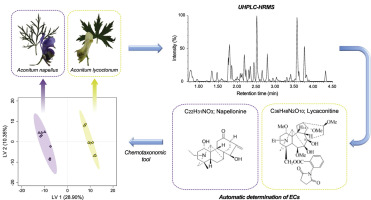当前位置:
X-MOL 学术
›
Phytochemistry
›
论文详情
Our official English website, www.x-mol.net, welcomes your
feedback! (Note: you will need to create a separate account there.)
Integration of non-targeted metabolomics and automated determination of elemental compositions for comprehensive alkaloid profiling in plants
Phytochemistry ( IF 3.2 ) Pub Date : 2018-10-01 , DOI: 10.1016/j.phytochem.2018.06.011 Maryse Vanderplanck , Gaétan Glauser
Phytochemistry ( IF 3.2 ) Pub Date : 2018-10-01 , DOI: 10.1016/j.phytochem.2018.06.011 Maryse Vanderplanck , Gaétan Glauser

|
Plants produce a large array of specialized metabolites to protect themselves. Among these allelochemicals, alkaloids display highly diverse and complex structures that are directly related to their biological activities. Plant alkaloid profiling traditionally requires extensive and time-consuming sample preparation and analysis. Herein, we developed a rapid and efficient approach for the comprehensive profiling of alkaloids in plants using ultrahigh performance liquid chromatography-high resolution mass spectrometry (UHPLC-HRMS)-based metabolomics. Using automated compound extraction and elemental composition assignment, our method achieved >83% correct alkaloid identification and even >90% for medium to high intensity peaks. This represented a significant improvement in identification rate compared to generic methods used for EC determination with no a priori, such as in untargeted metabolomics studies. The developed approach was then applied to identify specific alkaloids of Aconitum lycoctonum L. and A. napellus L. (Ranunculaceae) using different parts of the plant (leaf, perianth and pollen). Significant differences in alkaloid profiles between the two species were highlighted and discussed under taxonomic and evolutionary perspectives. Taken together, the presented approach constitutes a valuable chemotaxonomic tool in the search for known and unknown alkaloids from plants.
中文翻译:

整合非靶向代谢组学和元素组成的自动测定,用于植物中的综合生物碱分析
植物会产生大量专门的代谢物来保护自己。在这些化感物质中,生物碱表现出高度多样化和复杂的结构,与其生物活性直接相关。植物生物碱分析传统上需要大量且耗时的样品制备和分析。在此,我们开发了一种快速有效的方法,使用基于超高效液相色谱-高分辨率质谱 (UHPLC-HRMS) 的代谢组学对植物中的生物碱进行综合分析。使用自动化合物提取和元素组成分配,我们的方法实现了>83% 的正确生物碱鉴定,甚至>90% 的中高强度峰。与用于 EC 测定的通用方法相比,这代表了鉴定率的显着提高,没有先验,例如在非靶向代谢组学研究中。然后将开发的方法应用于使用植物的不同部分(叶、花被和花粉)鉴定乌头和 A. napellus L.(毛茛科)的特定生物碱。根据分类学和进化论的观点,突出并讨论了这两个物种之间生物碱谱的显着差异。总之,所提出的方法构成了一种有价值的化学分类工具,用于从植物中寻找已知和未知的生物碱。(毛茛科)使用植物的不同部分(叶、花被和花粉)。根据分类学和进化论的观点,突出并讨论了这两个物种之间生物碱谱的显着差异。总之,所提出的方法构成了一种有价值的化学分类工具,用于从植物中寻找已知和未知的生物碱。(毛茛科)使用植物的不同部分(叶、花被和花粉)。根据分类学和进化论的观点,突出并讨论了这两个物种之间生物碱谱的显着差异。总之,所提出的方法构成了一种有价值的化学分类工具,用于从植物中寻找已知和未知的生物碱。
更新日期:2018-10-01
中文翻译:

整合非靶向代谢组学和元素组成的自动测定,用于植物中的综合生物碱分析
植物会产生大量专门的代谢物来保护自己。在这些化感物质中,生物碱表现出高度多样化和复杂的结构,与其生物活性直接相关。植物生物碱分析传统上需要大量且耗时的样品制备和分析。在此,我们开发了一种快速有效的方法,使用基于超高效液相色谱-高分辨率质谱 (UHPLC-HRMS) 的代谢组学对植物中的生物碱进行综合分析。使用自动化合物提取和元素组成分配,我们的方法实现了>83% 的正确生物碱鉴定,甚至>90% 的中高强度峰。与用于 EC 测定的通用方法相比,这代表了鉴定率的显着提高,没有先验,例如在非靶向代谢组学研究中。然后将开发的方法应用于使用植物的不同部分(叶、花被和花粉)鉴定乌头和 A. napellus L.(毛茛科)的特定生物碱。根据分类学和进化论的观点,突出并讨论了这两个物种之间生物碱谱的显着差异。总之,所提出的方法构成了一种有价值的化学分类工具,用于从植物中寻找已知和未知的生物碱。(毛茛科)使用植物的不同部分(叶、花被和花粉)。根据分类学和进化论的观点,突出并讨论了这两个物种之间生物碱谱的显着差异。总之,所提出的方法构成了一种有价值的化学分类工具,用于从植物中寻找已知和未知的生物碱。(毛茛科)使用植物的不同部分(叶、花被和花粉)。根据分类学和进化论的观点,突出并讨论了这两个物种之间生物碱谱的显着差异。总之,所提出的方法构成了一种有价值的化学分类工具,用于从植物中寻找已知和未知的生物碱。











































 京公网安备 11010802027423号
京公网安备 11010802027423号